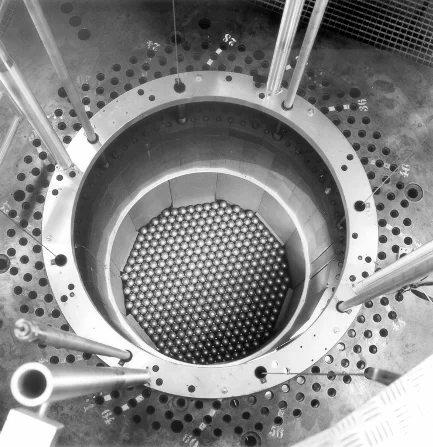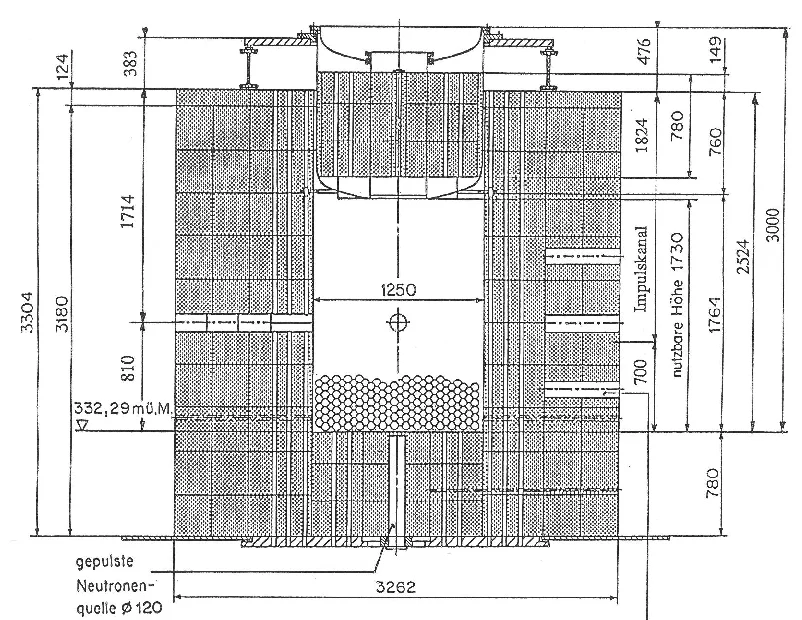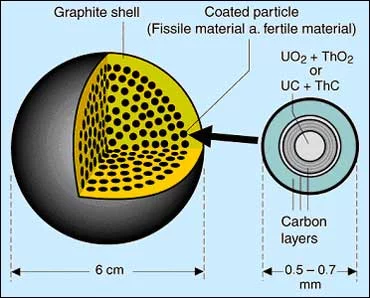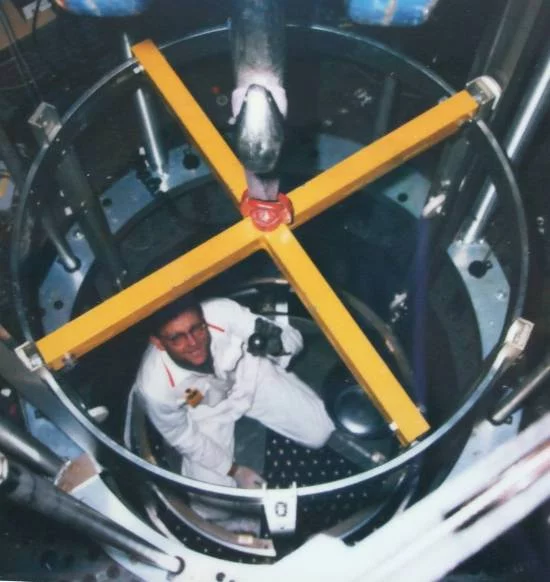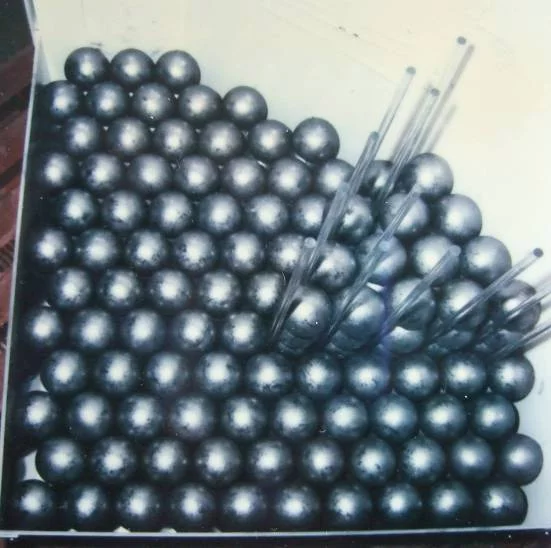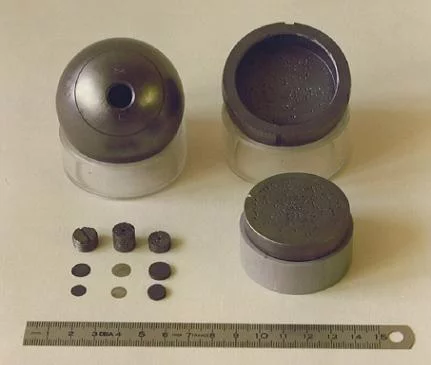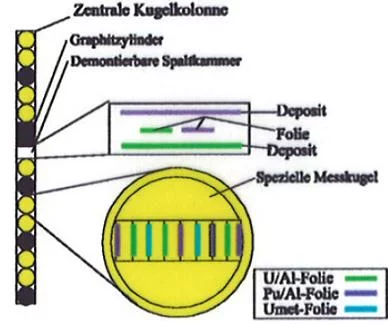Integral experiments aimed at validating safety-related calculations for low-enriched uranium high temperature reactors (LEU-HTRs)
By the end of the 1980s, there was a perceived need for integral physics
data related to small-sized, LEU-HTR (High Temperature Reactor) systems,
against which design and safety related calculations could be validated. In
previous experimental HTR-type reactors, the fuel type used had been mainly
high-enriched uranium (HEU) with thorium as fertile material. However, since
the priorities had shifted from fuel conservation to non-proliferation
accompanied by a refocusing upon low-enriched uranium (LEU) rather than
high-enriched fuel (i.e. with U-238 instead of Th-232 as the fertile material), a
considerable gap emerged in the available experimental database due to this
change in basic physics of HTR design. To fill the database gap, a programme of
integral experiments was designed at the PROTEUS facility.
This programme was carried out from July 1992 to July 1996 in the framework of an IAEA coordinated research programme with eight participating countries. Areas of special interest were the double-heterogeneity in LEU fuel, the neutron steaming effects in a pebble-bed type HTR, and the effects of accidental water ingress (since HTR systems generally tend to be under-moderated, an accident of this type can lead to large positive reactivity changes, in particular in the case of LEU fuel).
The HTR-PROTEUS programme has involved the measurement of various types of integral parameters such as the reactivity worth of absorber rods, reaction rate ratios and distributions, etc., for a range of different representative conditions. An important requirement in this context was the improvement of the accuracy of experimental techniques used to measure these parameters, in order to achieve a sufficiently reliable validation base for LEU-HTR calculational methods and data.
This programme was carried out from July 1992 to July 1996 in the framework of an IAEA coordinated research programme with eight participating countries. Areas of special interest were the double-heterogeneity in LEU fuel, the neutron steaming effects in a pebble-bed type HTR, and the effects of accidental water ingress (since HTR systems generally tend to be under-moderated, an accident of this type can lead to large positive reactivity changes, in particular in the case of LEU fuel).
The HTR-PROTEUS programme has involved the measurement of various types of integral parameters such as the reactivity worth of absorber rods, reaction rate ratios and distributions, etc., for a range of different representative conditions. An important requirement in this context was the improvement of the accuracy of experimental techniques used to measure these parameters, in order to achieve a sufficiently reliable validation base for LEU-HTR calculational methods and data.
A pebble-bed core was surrounded by
graphite reflectors. The top reflector could be removed to give access to
the pebble-bed. In the lower part of the bottom reflector, a pulsed
neutron source was placed. For the HTR-PROTEUS experimental programme, the
PROTEUS facility was configured as single-zone critical, multiplication
factor studies being of primary interest. The inner three zones (test
region, buffer, and D2O driver) of the preceding driven HCLWR configuration
were replaced by an axially reflected pebble-bed core. The core region
consisted of moderator (pure graphite) and fuel (16.7 % enriched) HTR-type
pebbles of 6 cm diameter, arranged in either deterministic or random
arrangements.
The High Temperature Reactor (HTR) is an advanced nuclear
reactor concept that was proposed for the first time in the late 1950s. In the
1990s, the interest in the HTR concept was substantially revived due to the
growing demand for an enhancement of the safety standards of nuclear plants,
which can be fulfilled by the inherent safety characteristics of the HTR.
Furthermore, the power conversion efficiency is higher than that of a
Light-Water Reactor (LWR), leading to a more efficient use of the fuel. This is
the result of the higher coolant outlet temperature in the HTR: about 900 °C
compared to about 300 °C in a LWR. The inherent safety characteristics of the
HTR are the result of several design features, viz.
- the use of coated fuel particles embedded in a graphite matrix which practically completely retain the fission products up to a fuel temperature of 1600 °C as confirmed by experiments,
- the use of graphite as both moderator for the neutrons and as construction material. In contrast to metals, graphite does not melt. Furthermore, its sublimation point is at a very high temperature (about 5100 K at atmospheric pressure),
- the use of helium as coolant,
- the low power density (2 to 6 MW/m3, compared to at least 50 MW/m3 for a LWR),
- a continuous fuel supply in case the core consists of spherical fuel elements, limiting the excess reactivity in the core to a minimum.
Because of the excellent retention capabilities of the coated fuel
particles, very high burnups are possible and the coolant circuit remains
practically free of contamination. Helium is chosen as coolant because it
hardly absorbs neutrons, is not activated by neutrons, is chemically inert,
does not undergo a phase change, has good heat-exchange properties, and is
naturally available in sufficient quantities.
If the core of an HTR consists of spherical fuel elements, the core cavity at start-up is filled with just enough fuel pebbles to make the system critical and to take it to full power. During operation, the reactivity decrease due to the burnup of the fuel is compensated by continuously adding fresh fuel pebbles. In this way, the excess reactivity is kept minimal and large reactivity accidents are not to be expected.
One of the most important safety requirements for reactor designs is the removal of decay heat from the reactor core in the case of an accident in order to prevent serious damage to the reactor and the release of radioactivity into the environment. First of all, the HTR core is temperature resistant, as only ceramic materials are used. Furthermore, due to the large amounts of graphite in an HTR, the core has a very high heat storage capacity, which is retained in the case of a loss-of-coolant accident. In such an accident, the combination of the large amounts of graphite and the low power density ensure a self-acting decay heat removal (by thermal radiation, heat conduction, and free convection) and a maximum fuel temperature that remains within an acceptable range. Hence, due to the basic physical properties of its design, the HTR excludes melting of the core and the release of radioactive fission products from the fuel elements under all conceivable anomalous conditions. Thus, it satisfies the requirements of inherently safe nuclear technology.
All the HTR test reactors developed before the 1990s used high-enriched uranium and thorium as fertile materials. Furthermore, the prototype designs generally had a rather large core diameter, due to which it was necessary to have control rods in the core region itself. Particularly in the pebble bed systems, this involved a number of serious engineering difficulties centred around the practical problem of rapidly inserting control rods through the pebble-bed without damaging the fuel. In new designs, the core diameter is reduced. This effects an increase of the neutron leakage to the reflector so that control rods in the reflector suffice and control rods in the core region are no longer required. Also, with priorities having shifted from fuel conservation to non-proliferation, the new designs use low-enriched uranium (LEU) with U-238 instead of Thorium as fertile material. For such LEU-HTR systems, the HTR-PROTEUS programme at the PROTEUS facility provided important experimental data for code and data validation.
If the core of an HTR consists of spherical fuel elements, the core cavity at start-up is filled with just enough fuel pebbles to make the system critical and to take it to full power. During operation, the reactivity decrease due to the burnup of the fuel is compensated by continuously adding fresh fuel pebbles. In this way, the excess reactivity is kept minimal and large reactivity accidents are not to be expected.
One of the most important safety requirements for reactor designs is the removal of decay heat from the reactor core in the case of an accident in order to prevent serious damage to the reactor and the release of radioactivity into the environment. First of all, the HTR core is temperature resistant, as only ceramic materials are used. Furthermore, due to the large amounts of graphite in an HTR, the core has a very high heat storage capacity, which is retained in the case of a loss-of-coolant accident. In such an accident, the combination of the large amounts of graphite and the low power density ensure a self-acting decay heat removal (by thermal radiation, heat conduction, and free convection) and a maximum fuel temperature that remains within an acceptable range. Hence, due to the basic physical properties of its design, the HTR excludes melting of the core and the release of radioactive fission products from the fuel elements under all conceivable anomalous conditions. Thus, it satisfies the requirements of inherently safe nuclear technology.
All the HTR test reactors developed before the 1990s used high-enriched uranium and thorium as fertile materials. Furthermore, the prototype designs generally had a rather large core diameter, due to which it was necessary to have control rods in the core region itself. Particularly in the pebble bed systems, this involved a number of serious engineering difficulties centred around the practical problem of rapidly inserting control rods through the pebble-bed without damaging the fuel. In new designs, the core diameter is reduced. This effects an increase of the neutron leakage to the reflector so that control rods in the reflector suffice and control rods in the core region are no longer required. Also, with priorities having shifted from fuel conservation to non-proliferation, the new designs use low-enriched uranium (LEU) with U-238 instead of Thorium as fertile material. For such LEU-HTR systems, the HTR-PROTEUS programme at the PROTEUS facility provided important experimental data for code and data validation.
During the HTR-PROTEUS experimental programme, investigations have been
carried out for a wide range of experimental conditions. In total, 11
different cores were configured (see Table below). Both stochastic and
deterministic pebble-loading arrangements have been studied, enabling not
only the variation of inter-pebble leakage ("streaming") effects, but also
permitting (in the case of the deterministic loadings) easy access to the
core centre for experimental purposes. Variation of the moderation ratio in
the core has been achieved by employing different loading ratios (2:1 and
1:1) for the fuel (graphite spheres containing coated LEU particles) and
moderator (pure graphite) pebbles. Appropriate simulation of accidental
ingress of water or steam into an HTR core was achieved using polyethylene
rods inserted into the vertical inter-pebble channels occurring in the
deterministic loadings.
| Core | F:M | Packing | Prominent Characteristic |
|---|---|---|---|
| 1 | 2:1 | HCP | Zebra control rods used instead of withdrawable SS rods |
| 1A | 2:1 | HCP | |
| 2 | 2:1 | HCP | Removal of upper reflector and placing of moderator pebble layers on top of core |
| 3 | 2:1 | HCP | Water ingress simulation (poly. rods, Ø8.9 mm) |
| 4 | 1:1 | Random | Stochastic loading |
| 5 | 2:1 | P-O-P | |
| 6 | 2:1 | P-O-P | Water ingress (poly. rods with copper) |
| 7 | 2:1 | P-O-P | Water ingress (poly. rods, Ø8.3 mm) |
| 8 | 2:1 | P-O-P | Partial water ingress (15-cm long poly. rods) |
| 9 | 1:1 | P-O-P | |
| 10 | 1:1 | P-O-P | Water ingress (poly rods, Ø6.5mm) |
| F:M stands for fuel-to-moderator ratio, HCP for hexagonal close packed and P-O-P for point-on-point (column hexagonal) packing | |||
In view of the importance of water ingress effects on shutdown rod worths
(accidental water ingress leads to a decrease of the worth of control rods
located in the reflector), a major part of the experimental effort was directed
towards control rod studies and other integral reactivity-effect
investigations. Different, largely independent, reactivity measurement
techniques - based on pulsed neutron source (PNS) and inverse kinetics (IVK)
methods, for the main part - were applied. In the PNS technique, the reactivity
of a subcritical system is obtained from its response to a regularly pulsed
neutron source. In the IVK technique, the reactivity is derived via the
analysis of the system response after, for example, the rapid insertion of an
absorber rod. The pronounced core/reflector interaction in pebble-bed cores
necessitates the application of relatively large calculated correction factors
to account for spatial effects in interpreting the conventional PNS
measurements, and a particular development has been that of PNS techniques
based on epithermal neutron detection.
The determination of individual neutron balance components in terms of reaction rate ratios in the doubly heterogeneous HTR fuel has been another important aspect of the safety-related investigations. Several new techniques have been developed, e.g. the measurement of C8/Ftot (U-238 capture, relative to total fissions) via the utilisation of specially fabricated graphite "foils" containing an appropriate number of UO2 particles. Radial and axial reaction rate distributions across the pebble bed were measured by various methods, viz. miniature fission chambers, activation foils, as well as the gamma-counting of entire fuel pebbles "extracted" from appropriate core positions.
The determination of individual neutron balance components in terms of reaction rate ratios in the doubly heterogeneous HTR fuel has been another important aspect of the safety-related investigations. Several new techniques have been developed, e.g. the measurement of C8/Ftot (U-238 capture, relative to total fissions) via the utilisation of specially fabricated graphite "foils" containing an appropriate number of UO2 particles. Radial and axial reaction rate distributions across the pebble bed were measured by various methods, viz. miniature fission chambers, activation foils, as well as the gamma-counting of entire fuel pebbles "extracted" from appropriate core positions.
There have been several noteworthy findings, e.g. that results for
multiplication factor are quite sensitive to the modelling of the
core/reflector interface and that, in the assessment of reactivity changes
associated with water ingress, it is important to take proper account of
neutron streaming effects. As regards the improvements in measurement
techniques, the use of epithermal detectors in reactivity measurements allowed
the determination of reactivities up to 15 $ with a significantly reduced
experimental uncertainty of about 1.5 %.
Rosselet M., Chawla R., Williams T., "Epithermal Inverse Kinetic
Measurements and their Interpretation using a Two-Group Point Kinetic
Model," Nucl. Sci. and Eng., 135 (2000)
Williams T., Rosselet M., Chawla R., Wallerbos E., van Dam H., "Experimental Investigation of the Kinetics Parameter ß eff/Lambda in Graphite-Moderated, LEU Fueled, Critical Configurations," Proc. Int. Conf. On the Physics of Reactors - PHYSOR 96, Mito City (Japan), September 1996
Chawla R., "Generic Reactor Physics Studies in the Framework of the PROTEUS LEU-HTR Programme," Invited Paper IXth Brazilian Mtg. on Reactor Physics and Thermal Hydraulics, Caxambu (Brazil), October 25-29, 1993
Wallerbos E.J.M., "Reactivity Effects in a Pebble-Bed Type Nuclear Reactor," Thesis Delft University of Technology (1998)
Körbel O., "Experimentelle Neutronenbilanzuntersuchungen zum Wassereinbruch in einen Hochtemperaturreaktor mit Niedrig Angereichertem Uranbrennstoff," Thesis Swiss Federal Institute of Technology Lausanne (1998)
Rosselet M., "Reactivity Measurements and their Interpretation in Systems with Large Spatial Effects," Thesis Swiss Federal Institute of Technology Lausanne (1999)
Rosselet M., Williams T., Chawla R., "Subcritical Measurements Using an Epithermal Pulsed-Neutron Source Technique in Pebble-Bed HTR Configurations." Ann. Nucl. Energy, 25, 285-294 (1998).
Rosselet M., Wiliams T., Chawla R., "Investigation of the k eff -Variation upon Water Ingress in a Pebble-Bed LEU-HTR." Ann. Nucl.Energy, 26, 75-82 (1999).
Köberl O., Chawla R., Seiler R., "Neutron Balance Experiments Related to Simulated Water Ingress in a LEU-HTR Pebble-Bed System." 9th Int. Conf. on Emerging Nuclear Energy Systems, 28 June - 2 July 1998, Tel-Aviv, Israel, pp. 537-544.
Rosselet M., Chawla R., Joneja O. P., Williams T., "Measurements ans Analysis of Shutdown Rod Worths in LEU-HTR Configurations." ICENES2000, 25.-28. September 2000, Petten, The Netherlands.
Williams T., Rosselet M., Chawla R., Wallerbos E., van Dam H., "Experimental Investigation of the Kinetics Parameter ß eff/Lambda in Graphite-Moderated, LEU Fueled, Critical Configurations," Proc. Int. Conf. On the Physics of Reactors - PHYSOR 96, Mito City (Japan), September 1996
Chawla R., "Generic Reactor Physics Studies in the Framework of the PROTEUS LEU-HTR Programme," Invited Paper IXth Brazilian Mtg. on Reactor Physics and Thermal Hydraulics, Caxambu (Brazil), October 25-29, 1993
Wallerbos E.J.M., "Reactivity Effects in a Pebble-Bed Type Nuclear Reactor," Thesis Delft University of Technology (1998)
Körbel O., "Experimentelle Neutronenbilanzuntersuchungen zum Wassereinbruch in einen Hochtemperaturreaktor mit Niedrig Angereichertem Uranbrennstoff," Thesis Swiss Federal Institute of Technology Lausanne (1998)
Rosselet M., "Reactivity Measurements and their Interpretation in Systems with Large Spatial Effects," Thesis Swiss Federal Institute of Technology Lausanne (1999)
Rosselet M., Williams T., Chawla R., "Subcritical Measurements Using an Epithermal Pulsed-Neutron Source Technique in Pebble-Bed HTR Configurations." Ann. Nucl. Energy, 25, 285-294 (1998).
Rosselet M., Wiliams T., Chawla R., "Investigation of the k eff -Variation upon Water Ingress in a Pebble-Bed LEU-HTR." Ann. Nucl.Energy, 26, 75-82 (1999).
Köberl O., Chawla R., Seiler R., "Neutron Balance Experiments Related to Simulated Water Ingress in a LEU-HTR Pebble-Bed System." 9th Int. Conf. on Emerging Nuclear Energy Systems, 28 June - 2 July 1998, Tel-Aviv, Israel, pp. 537-544.
Rosselet M., Chawla R., Joneja O. P., Williams T., "Measurements ans Analysis of Shutdown Rod Worths in LEU-HTR Configurations." ICENES2000, 25.-28. September 2000, Petten, The Netherlands.

